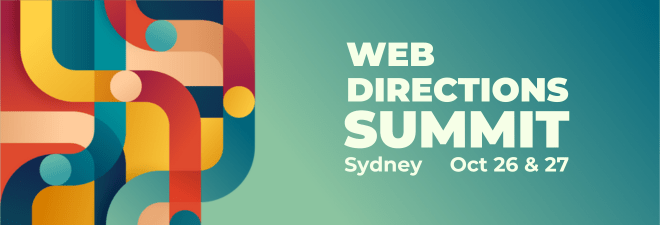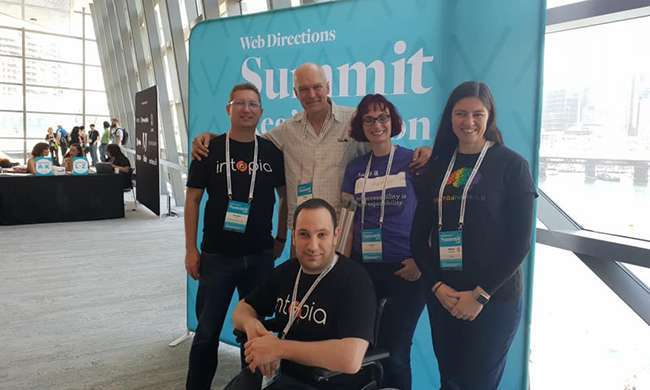
I’m very excited about going to the Web Directions Summit conference this year.
Web Directions and I go way back. Back even to before Web Directions was Web Directions.
I’d been dabbling in this new fangled World Wide Web since the mid 90s. At the time, I was working at the Disability Information & Referral Centre in eastern Sydney, a new service funded by the State and Federal governments to provide information to people with disabilities and their families in (originally) five local government areas.
It was originally a phone-based information service co-located with a branch of the NSW Department of Community Services, which was one of the main providers of services to the families of children with intellectual disabilities at the time.
The first Manager was the mother of a teenager with Down syndrome, who happened to be a librarian and thus had lived experience of the need for such a service and had information management skills. I was hired as Information Officer on the basis of the information management and IT skills I’d acquired at a previous job.
We used the text-based AskSam data management system to store all the information we could gather about disabilities, impairments, handicaps and disorders, their impact on families and sources of ongoing information about products, services and support.
When the Internet appeared, I used it connect to a South Australian bulletin board called The Level Playing Field, which opened us up to information on a national and international scale.
It should be noted that while we focused on Eastern Sydney, no equivalent services had yet been funded in other parts of Sydney, so we became a de facto service for a whole city of 4 million people. We were busy, and even more so as legislation was enacted to support young people with disabilities to move out of institutions and into group homes.
After a few years, the Manager retired and I took over, just as computers were moving to more graphic user interfaces and the World Wide Web was starting up. It was pretty obvious that putting our information on the Web and letting people search it would be a boon for us and the people who needed the information.
So, I built my first website for DIRC in 1994.

I continued working for DIRC for several more years, with both our information database and our Web presence getting more sophisticated, and more heavily trafficked. I managed to overhaul our Management Committee from being mostly comprised of local, state and federal government representatives to people with lived experience of disability.
I joined the committees and boards of many other local service providers to broaden and deepen my knowledge both of managing small funded organisations and the subject areas they dealt with, such as the NSW Disability Discrimination Legal Centre and Enterprise Employment, a provider of employment support to young adults with intellectual disabilities.
Eventually, I left DIRC to take up a job with People With Disability NSW, a statewide advocacy organisation, initially as IT Support and eventually running their information services. Again, this involved building a website that became bigger and better, even as the organisation grew to become PWD Australia, with a national brief. I also created another email newsletter, something I’ve continued doing ever since for everyone I worked for and with.
My departure from PWD was not a happy one, and I decided I’d stop working for others and try working for myself. I called myself a Web Designer / Developer but that title was more what we’d now called a Visual Designer, UX Designer, Front End Developer and Content Producer combined.

In fact, that was my selling point – I was a jack of all web trades. You want a website? I can do it all for you, and much cheaper than these new agencies springing up everywhere, most of which were advertising agencies with an eye to expanding into the web.
By the early 2000s, I was doing pretty well. I had the sense to build myself a good-looking, fast-loading and well-populated website as a shopfront for my skills. This brought me enough work that I was kept busy and earning a decent income.
I allocated myself $1,000 a year as a professional skills development budget, and I signed up to both virtual and face-to-face courses and bought myself a LOT of books.
Then, in 2004, I somehow got wind of this new tech conference called Web Essentials.
They weren’t the only web tech conference around, and I had been to a couple of others, but Web Essentials was a whole new ballgame.
For one thing, they had a clear and overt commitment to web standards. I had already seen through the graphic design-driven approaches to web design pushed by ad agencies and had read books and web articles by people like Jeffrey Zeldman, (the late) Molly Holzschlag, Eric Meyer, Tantek Çelik, and Jeffrey Veen, who took to heart WWW inventor Tim Berners Lee’s dictum that the web should be interoperable, usable and – hello – accessible to people with disabilities.
I already knew the truth of this because this was exactly why I started building websites. But here were people quantifying exactly why that should be done and how it could be done.
Web Essentials not only showcased local people who put this into practice, like Russ Weakley, but brought those US experts to Sydney to show and tell us how it could be done.
I had found my tribe, my people, a source of ongoing inspiration, challenge and identification.
Web Essentials 2005, that famously difficult second album/book/artwork/song/play, was not just more of the same, it was more of everything!
In 2006, the organisers had a change of personnel and the conference became Web Directions, which it has remained ever since. That doesn’t mean it remained static, though. The organisers, John Allsopp and Maxine Sherrin, were only getting started.
They created spin-off conferences dedicated to branches of expertise within the overall web tech sphere: visual design, markup, coding, government, JavaScript, leadership, performance, even as these areas became more specialised and sophisticated.
They expanded geographically, too, adding conferences in Melbourne, Brisbane, Canberra, wherever enough people willing to sign up could gather for a day or two of intensive – and intense – professional tech skills development. At various times they ran Web Directions conferences in Japan, the UK and the USA.
In 2008, I spent five times my annual budget to attend Web Directions North in Vancouver, Canada. It was a dream lineup of speakers, and I learned enough to heighten my ambitions for several years. Along the way, I got to meet many of my heroes. That event remains the best web conference I’ve ever been to, and it was more than worth every penny.
From the early days of Web Directions, I’d acquired the habit of writing up wrap-ups of the conferences and posting them to my blog. This was a convenient way for me to summarise the events for myself and share some of their impact on me with others.
Those blog posts are still on my website. In fact, my oldest existing post is my write-up of Web Directions South in 2006.
When Twitter came along, I also did a fair bit of live tweeting at various Web Directions events, another way of both recording and sharing my experiences.
This activity came to the attention of the Web Directions organisers and, to cut an increasingly long story a bit shorter, I scored a job on the Web Directions team. For a few years, I worked on Web Directions newsletters, website copy, speaker preparation, attendee liaisons and social media.
The high point was undoubtedly when I worked on John’s idea for a physical magazine to accompany the conferences, partly an acknowledgement that the traditional conference program booklets were being replaced by web content and partly a way of creating a high quality memento of the event to take away.
I still have copies of all the editions the physical magazine we created, Scroll – with glorious visual design by Michael Schepis and his team at Handle Branding – and the digital post-conference editions, called Wrap. For a bloke of my vintage, bringing together words in print – on paper, and digitally – with stunning visuals and amazingly high quality production standards, all on the topic of the web world to which I’d committed myself, was a peak achievement.

Scroll and Wrap only lasted a couple of years, five or six editions of each, before it had to be conceded that this beautiful idea was not realistically sustainable in the long run, at least not without some significant production and distribution partnerships we didn’t have.
That also became the cue for me to shift back from a WD team member to a punter, attending every conference I can – acknowledging the hiatus that Covid forced on most of us.
During the time I worked for Web Directions, I kept up my portfolio of web design clients and I picked up other work that both kept body and soul together and enriched my professional life, not least among them becoming Managing Editor at web tech publisher SitePoint and Communications Manager for UX Australia, another producer of high quality web tech conferences.
Underpinning all my work and professional development during that time has been an awareness of and commitment to digital accessibility. It still seems obvious to me that accessibility is and must be one of the most basic planks of all web design and development.
That has, in turn, led to my working with outstanding agencies in the field like Intopia and my ongoing membership of OZeWAI, both of which helped continue my attendance at Web Directions events.

I find it rather funny that simply believing in accessibility and assuming it is part of my job has led me to being a Technical Content Writer for a global accessibility corporation like TPG Interactive, where I write content that a massive team of accessibility engineers and auditors use to audit websites around the world and tell their owners how to make them accessible.
All this happened because almost 20 years ago, I came across the Web Directions approach to professional web tech development, informed by a commitment to web standards and accessibility, and I’ve never left it.
I can’t tell you how much I’m looking forward to this year’s huge Web Directions Summit conference in Sydney in October. I hope I see you there.
Originally published at https://ozewai.org/blog/ozewai-news/web-directions-and-me/.